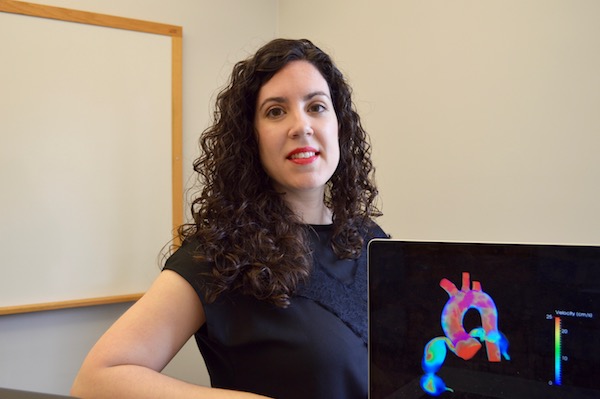Simulating fluid flow to study disease
New faculty profile: Noelia Grande Gutiérrez
Emily Schneider
Aug 16, 2021
How different can the flow of air past an airplane be from the flow of blood through our body? To Noelia Grande Gutiérrez, the two are more similar than one may think. Her early education and experience in the former led her towards a path in academia in the latter.
“As an aerospace engineer, I had a lot of background in fluid mechanics,” said Grande Gutiérrez, a new faculty member in the Department of Mechanical Engineering. “I saw how you could apply those same principles into understanding, for example, how the respiratory or the cardiovascular system works.”

Grande Gutiérrez joins Carnegie Mellon University's mechanical engineering faculty in fall 2021.
Grande Gutiérrez returned to school to study biomedical engineering, and eventually completed a Ph.D. Her work has primarily focused on using computational modeling to study the cardiovascular system and diseases related to it.
One of those conditions is thrombosis, or a clot blocking blood flow. Thrombosis can lead to anything from swelling and pain in the limbs to heart attacks or strokes. Computational models can study how blood flow affects both the formation and growth of the clot. By understanding how that process is different for each patient, we can better understand who could be at risk for thrombosis and design personalized therapies.
She plans to continue this work here at Carnegie Mellon University, as well as explore another large issue in cardiovascular disease. Namely, she wants to work to understand how sex differences can affect the disease or detection of it. For example, coronary artery disease is very underestimated in women because much of the research was conducted on men. She wants to use simulations to extract predictors of adverse effects in women to help diagnose the disease before it’s too late.
I saw how you could apply those same [fluid mechanics] principles into understanding, for example, how the respiratory or the cardiovascular system works.
Noelia Grande Gutiérrez, Assistant Professor, Mechanical Engineering, Carnegie Mellon University
She also hopes to explore drug delivery problems, especially in precisely targeting certain destinations. Medicines such as cancer therapies are rather toxic to healthy cells, and therefore precise delivery can mitigate off-target side effects.
This fall, Grande Gutiérrez will teach a course on computational fluid dynamics and hopes to develop a new course on modeling biological systems sometime in the future. She’s long been a supporter of students, especially women, interested in careers in engineering or academia. A first-generation student herself, she hopes she can serve as a role model for others following a similar path.
She’s ready to bring together her first group of researchers and get started on these projects, taking advantage of the wealth of interdisciplinary knowledge offered here at Carnegie Mellon.
Grande Gutiérrez earned her bachelor’s degree from Technical University of Madrid, then a master’s in both biomedical engineering from the University of Barcelona and engineering sciences and applied mechanics from the University of California, San Diego. She earned her Ph.D. in mechanical engineering from Stanford University in 2019, and now comes to Carnegie Mellon to serve as an assistant professor of mechanical engineering.
Media contact:
Lisa Kulick, lkulick@andrew.cmu.edu